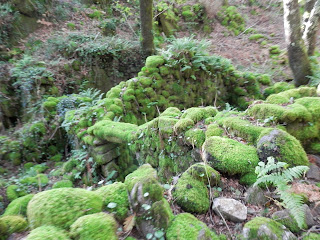CELTIC HILL-FORTS AND IBERIANS IN NORTHWESTERN SPAIN
CASTROS CELTAS - CULTURA IBÉRICA EN GALICIA
CULTURA CASTREXA GALEGA
Hispania / Iberia: Santa Trega (Celtic hill-fort, castrum in province of Gallaecia)
by E.V.Pita
The Celtic hill-fort of Santa Tegra is the most famous hill-fort of Galicia, Spain. It's an ancient village in a top of a hill, between the River Minho and the Atlantic Ocean.
http://archeopolis.blogspot.com/2011/06/santa-tecra-celtic-castrum-in-iberia.html
The Celtic hill-fort of Santa Tegra is the most famous hill-fort of Galicia, Spain. It's an ancient village in a top of a hill, between the River Minho and the Atlantic Ocean.
http://archeopolis.blogspot.com/2011/06/santa-tecra-celtic-castrum-in-iberia.html
Santa Tecla: castro prerromano / Monte Tegra: castro prerromano
por E.V.PitaEl castro de Santa Tecla, en A Guarda (Pontevedra) es el más famoso castro de Galicia y uno de los monumentos más visitados de Galicia. Es un viejo pueblo fortificado situado en lo alto de una colina que domina la desembocadura del río Miño y el océano Atlántico.
 |
| Mount Castro hill-fort in Vigo / Castro prerromano de Vigo |
Celtiberia, Mount Castro hill fort in Vigo
by E.V.Pita
Mount Castro of Vigo is where a PreRoman villa of the Iron Age settled. It was inhabited until the end of the Roman Empire.
Castro prerromano de Vigo
por E.V.Pita
El monte Castro de Vigo es el lugar donde se asentó una villa prerromana de la Edad de Hierro. Estuvo habitado hasta el final del Imperio Romano.
O monte do Castro foi o lugar elexido por un pobo prerromano para asentar unha vila na Idade de Ferro. Estivo habitado ata o final do Imperio Romano.
.........................................................................................................................................
 |
| Panoramical views of hill fort of Borneiro Vista panorámica de Castro de Borneiro |
Spain, Celtiberian hill-fort in Borneiro
pictures by E.V.Pita
The fort of Borneiro (Cabana de Bergantiños) was inhabited from the third century BC and the second century AC. Most houses are circular but there are some square, Roman influence. The fort is protected by a circular wall. There were workshops and a "croa" or acropolis. It is on a hill, near a river and a forest, three kilometers from the sea.
The fort of Borneiro (Cabana de Bergantiños) was inhabited from the third century BC and the second century AC. Most houses are circular but there are some square, Roman influence. The fort is protected by a circular wall. There were workshops and a "croa" or acropolis. It is on a hill, near a river and a forest, three kilometers from the sea.
Castro de Borneiro en Cabana de Bergantiños
por E.V.Pita
El castro de Borneiro (Cabana de Bergantiños, provincia de A Coruña) estuvo habitado entre el siglo III antes de Cristo y el siglo II después de Cristo. La mayoría de las casas son circulares pero hay algunas de planta cuadrada, de influencia romana. El castro está protegido por una muralla circular. Allí había talleres y una croa o acrópolis. Está en un montículo, junto a un río y un bosque, a tres kilómetros del mar.
El castro de Borneiro (Cabana de Bergantiños, provincia de A Coruña) estuvo habitado entre el siglo III antes de Cristo y el siglo II después de Cristo. La mayoría de las casas son circulares pero hay algunas de planta cuadrada, de influencia romana. El castro está protegido por una muralla circular. Allí había talleres y una croa o acrópolis. Está en un montículo, junto a un río y un bosque, a tres kilómetros del mar.
A "Cidá" de Borneiro (Costa da Morte)
O castro de Borneiro (Cabana de Bergantiños, provincia da Coruña) estivo habitado entre o século III antes de Cristo e o século II despois de Cristo. A maioría das casas son circulares pero hai algunhas de pranta cadrada, de influencia romana. O castro está protexido por unha muralla circular. Alí había obradoiros e unha croa ou acrópole. Está nun outeiro, onda un río e un bosque, a tres kilómetros do mar.
.............................................................................................................................................
Iberia: Prerroman houses in O Cebreiro
by E.V.Pita
Iberia: pallozas en O Cebreiro
por E.V.Pita
..............................................................................................
 |
| The old city / La ciudadela / A cidade |
THE OLD CITY - CELTIC HILL-FORT
(FORNELOS DE MONTES)
by E.V.Pita
LA CIUDADELA - CASTRO
por E.V.Pita
A CIDADE - CASTRO
(FORNELOS DE MONTES)
...........................................................................................................................................
(Hispania) Impregnable celtic fort-hill of Vilar (Roman province of Gallaecia)
Castro inexpugnable de Vilar (Lugo, Galicia)
...............................................................................................................................................
BRONCE SWORDS AND GOLD AGE (FORT-HILLS AGE)
BRONCE SWORDS AND GOLD AGE (FORT-HILLS AGE)
WARRIOR TRIBES FROM NORTHWEST IBERIA HILL-FORTS
Pictures: Exhibition in the Castle of San Anton Archaeological Museum of Corunna (Galicia, Spain)
ESPADAS DE BRONCE Y ORO (ÉPOCA DE LOS CASTROS)
TRIBUS GUERRERAS DEL NOROESTE DE IBERIA
Fotos obtenidas en los fondos expuestos del Museo Arqueológico del Castillo de San Antón en A Coruña
COITELOS DE BRONCE E OURO (ÉPOCA CASTREXA)
POVOS GUERREIROS DOS CASTROS DO NOROESTE DE IBERIA
Fotos sacadas na mostra do Museu Arqueolóxico do Castelo de Santo Antón na Coruña
......................................................................................................................................



